2007 CHEVROLET TRAIL BLAZER belt
[x] Cancel search: beltPage 206 of 574

If, after several seconds, all status indicator lights
remain on, or if there are no lights at all, there
may be a problem with the lights or the passenger
sensing system. See your dealer for service.
{CAUTION:
If the off indicator and the airbag
readiness light ever come on together,
it means that something may be wrong
with the airbag system. If this ever
happens, have the vehicle serviced
promptly, because an adult-size person
sitting in the right front passenger seat
may not have the protection of the frontal
airbag. SeeAirbag Readiness Light
on page 202.
Charging System Light
The charging system
light will come on brie�y
when you turn on
the ignition, but the
engine is not running,
as a check to show
you it is working.
It should go out once the engine is running.
If it stays on, or comes on while you are driving,
you may have a problem with the charging system.
It could indicate that you have problems with a
generator drive belt, or another electrical problem.
Have it checked right away. Driving while this
light is on could drain your battery.
If you must drive a short distance with the light on,
be certain to turn off all your accessories, such
as the radio and air conditioner.
206
Page 239 of 574

Notice:Before adding any sound equipment
to your vehicle, such as an audio system,
CD player, CB radio, mobile telephone,
or two-way radio, make sure that it can be
added by checking with your dealer/retailer.
Also, check federal rules covering mobile radio
and telephone units. If sound equipment can
be added, it is very important to do it properly.
Added sound equipment may interfere with
the operation of your vehicle’s engine, radio,
or other systems, and even damage them.
Your vehicle’s systems may interfere with
the operation of sound equipment that
has been added.
Notice:The chime signals related to safety
belts, parking brake, and other functions
of your vehicle operate through the radio/
entertainment system. If that equipment
is replaced or additional equipment is added
to your vehicle, the chimes may not work.
Make sure that replacement or additional
equipment is compatible with your vehicle
before installing it. SeeAccessories and
Modifications on page 386.Your vehicle may have a feature called Retained
Accessory Power (RAP). With RAP, the audio
system can be played even after the ignition is
turned off. SeeRetained Accessory Power (RAP)
on page 113for more information.
Setting the Time
The radio may have a button marked with
an H or HR to represent hours and an M or MN
to represent minutes.
Press and hold the hour button until the correct
hour displays. AM or PM displays for morning
or evening hours. Press and hold the minute
button until the correct minute displays. The
time can be set with the ignition on or off.
To synchronize the time with an FM station
broadcasting Radio Data System (RDS)
information, press and hold the hour and minute
buttons at the same time until UPDATED and the
clock symbol appear on the display. If the time
is not available from the station, NO UPDATE
or NO UPDAT will appear on the display.
RDS time is broadcast once a minute. After
tuning to an RDS broadcast station, it could
take a few minutes for the time to update.
239
Page 306 of 574

Your Driving, the Road, and
Your Vehicle
Defensive Driving
The best advice anyone can give about driving is:
Drive defensively.
Please start with a very important safety device in
your vehicle: Buckle up. SeeSafety Belts: They
Are for Everyone on page 20.
{CAUTION:
Defensive driving really means “Be ready
for anything.” On city streets, rural roads,
or expressways, it means “Always expect
the unexpected.” Assume that pedestrians
or other drivers are going to be careless
and make mistakes. Anticipate what they
might do and be ready. Rear-end collisions
are about the most preventable of
accidents. Yet they are common. Allow
enough following distance. Defensive
driving requires that a driver concentrate
on the driving task. Anything that distracts
from the driving task makes proper
defensive driving more difficult and can
even cause a collision, with resulting
injury. Ask a passenger to help do these
things, or pull off the road in a safe place to
do them. These simple defensive driving
techniques could save your life.
306
Page 320 of 574
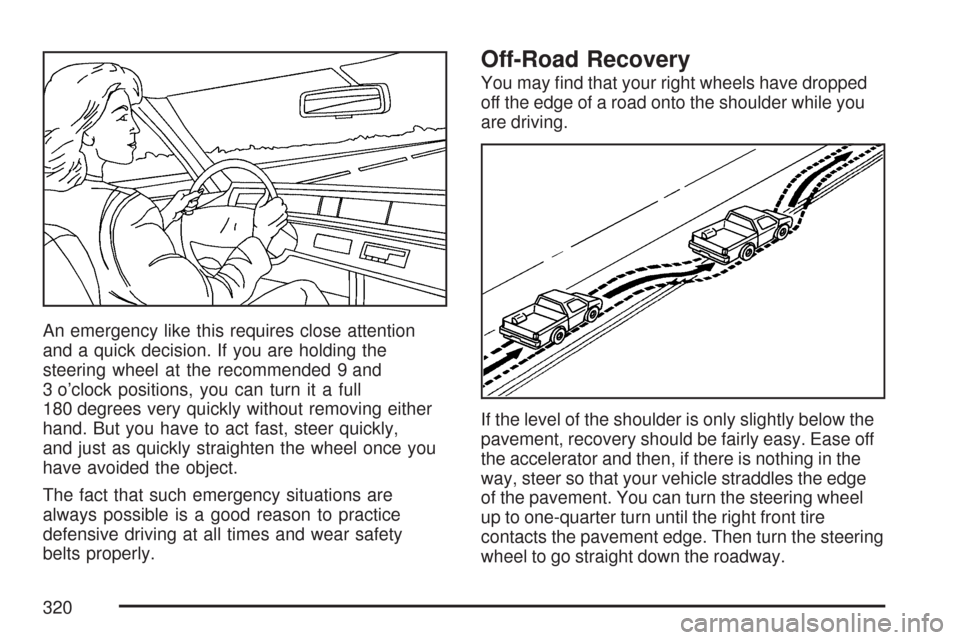
An emergency like this requires close attention
and a quick decision. If you are holding the
steering wheel at the recommended 9 and
3 o’clock positions, you can turn it a full
180 degrees very quickly without removing either
hand. But you have to act fast, steer quickly,
and just as quickly straighten the wheel once you
have avoided the object.
The fact that such emergency situations are
always possible is a good reason to practice
defensive driving at all times and wear safety
belts properly.
Off-Road Recovery
You may �nd that your right wheels have dropped
off the edge of a road onto the shoulder while you
are driving.
If the level of the shoulder is only slightly below the
pavement, recovery should be fairly easy. Ease off
the accelerator and then, if there is nothing in the
way, steer so that your vehicle straddles the edge
of the pavement. You can turn the steering wheel
up to one-quarter turn until the right front tire
contacts the pavement edge. Then turn the steering
wheel to go straight down the roadway.
320
Page 324 of 574
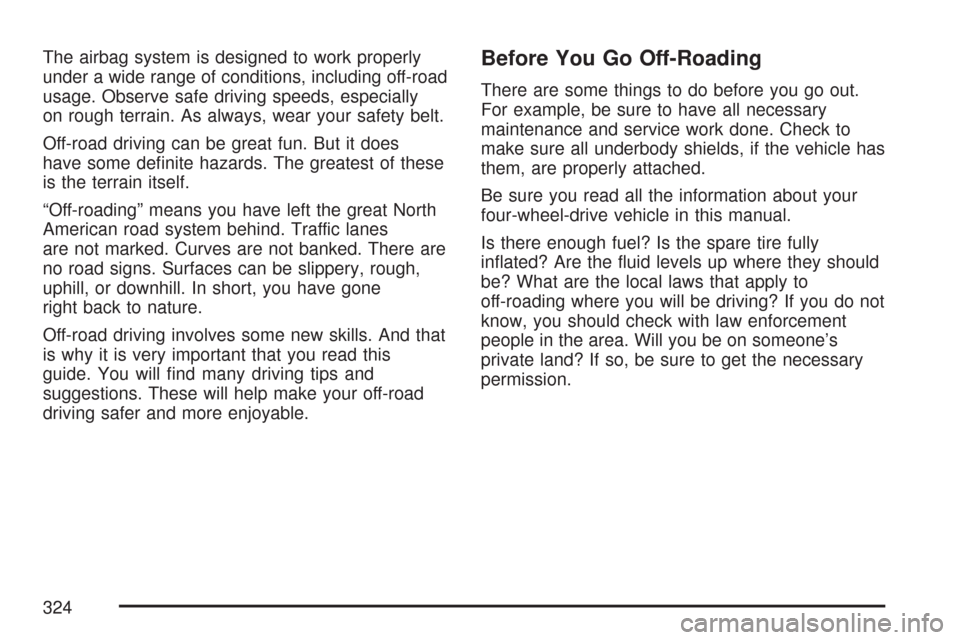
The airbag system is designed to work properly
under a wide range of conditions, including off-road
usage. Observe safe driving speeds, especially
on rough terrain. As always, wear your safety belt.
Off-road driving can be great fun. But it does
have some de�nite hazards. The greatest of these
is the terrain itself.
“Off-roading” means you have left the great North
American road system behind. Traffic lanes
are not marked. Curves are not banked. There are
no road signs. Surfaces can be slippery, rough,
uphill, or downhill. In short, you have gone
right back to nature.
Off-road driving involves some new skills. And that
is why it is very important that you read this
guide. You will �nd many driving tips and
suggestions. These will help make your off-road
driving safer and more enjoyable.Before You Go Off-Roading
There are some things to do before you go out.
For example, be sure to have all necessary
maintenance and service work done. Check to
make sure all underbody shields, if the vehicle has
them, are properly attached.
Be sure you read all the information about your
four-wheel-drive vehicle in this manual.
Is there enough fuel? Is the spare tire fully
in�ated? Are the �uid levels up where they should
be? What are the local laws that apply to
off-roading where you will be driving? If you do not
know, you should check with law enforcement
people in the area. Will you be on someone’s
private land? If so, be sure to get the necessary
permission.
324
Page 327 of 574
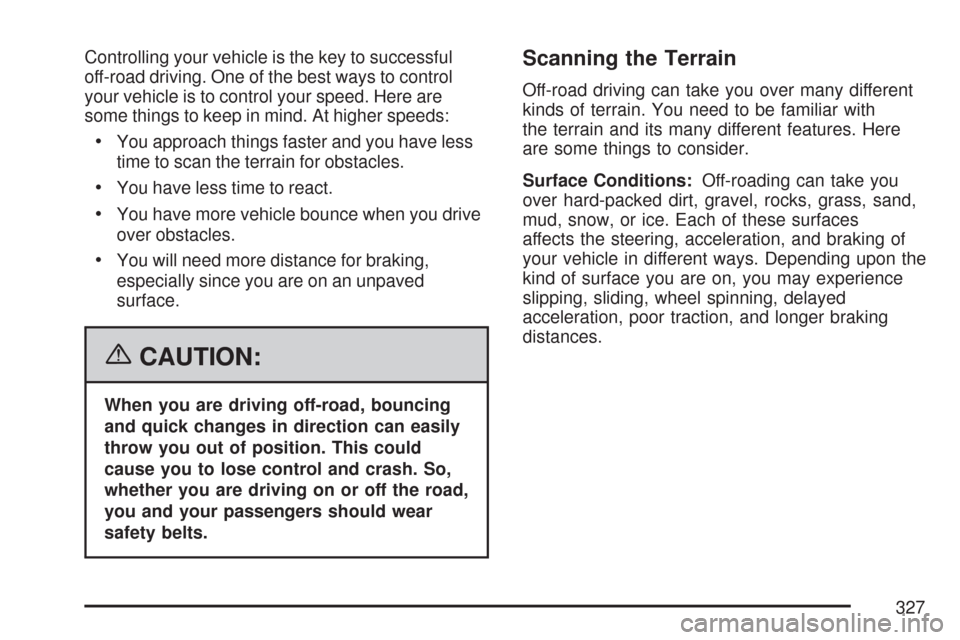
Controlling your vehicle is the key to successful
off-road driving. One of the best ways to control
your vehicle is to control your speed. Here are
some things to keep in mind. At higher speeds:
You approach things faster and you have less
time to scan the terrain for obstacles.
You have less time to react.
You have more vehicle bounce when you drive
over obstacles.
You will need more distance for braking,
especially since you are on an unpaved
surface.
{CAUTION:
When you are driving off-road, bouncing
and quick changes in direction can easily
throw you out of position. This could
cause you to lose control and crash. So,
whether you are driving on or off the road,
you and your passengers should wear
safety belts.
Scanning the Terrain
Off-road driving can take you over many different
kinds of terrain. You need to be familiar with
the terrain and its many different features. Here
are some things to consider.
Surface Conditions:Off-roading can take you
over hard-packed dirt, gravel, rocks, grass, sand,
mud, snow, or ice. Each of these surfaces
affects the steering, acceleration, and braking of
your vehicle in different ways. Depending upon the
kind of surface you are on, you may experience
slipping, sliding, wheel spinning, delayed
acceleration, poor traction, and longer braking
distances.
327
Page 380 of 574
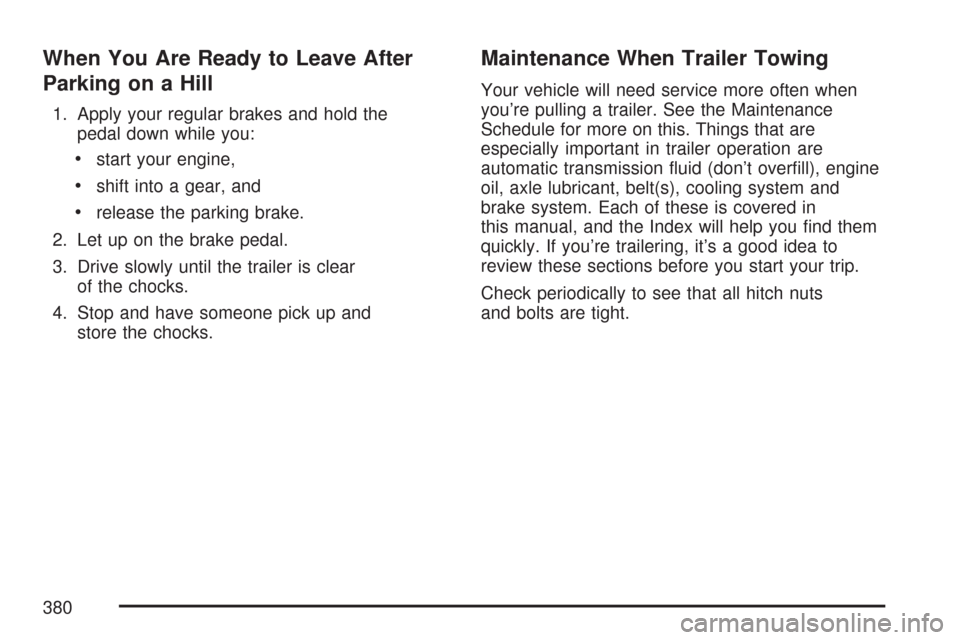
When You Are Ready to Leave After
Parking on a Hill
1. Apply your regular brakes and hold the
pedal down while you:
start your engine,
shift into a gear, and
release the parking brake.
2. Let up on the brake pedal.
3. Drive slowly until the trailer is clear
of the chocks.
4. Stop and have someone pick up and
store the chocks.
Maintenance When Trailer Towing
Your vehicle will need service more often when
you’re pulling a trailer. See the Maintenance
Schedule for more on this. Things that are
especially important in trailer operation are
automatic transmission �uid (don’t over�ll), engine
oil, axle lubricant, belt(s), cooling system and
brake system. Each of these is covered in
this manual, and the Index will help you �nd them
quickly. If you’re trailering, it’s a good idea to
review these sections before you start your trip.
Check periodically to see that all hitch nuts
and bolts are tight.
380
Page 384 of 574
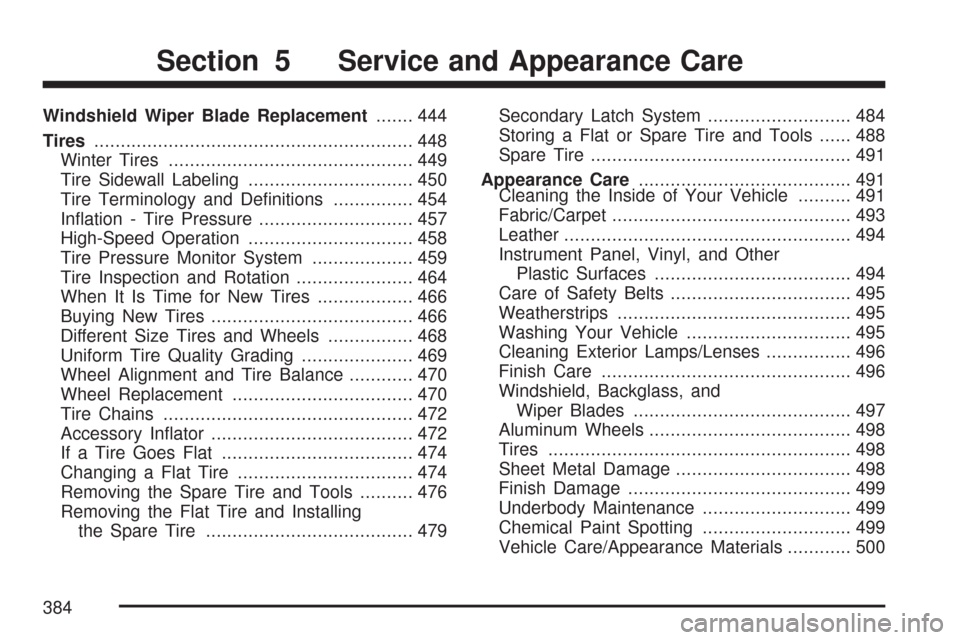
Windshield Wiper Blade Replacement....... 444
Tires............................................................ 448
Winter Tires.............................................. 449
Tire Sidewall Labeling............................... 450
Tire Terminology and De�nitions............... 454
In�ation - Tire Pressure............................. 457
High-Speed Operation............................... 458
Tire Pressure Monitor System................... 459
Tire Inspection and Rotation...................... 464
When It Is Time for New Tires.................. 466
Buying New Tires...................................... 466
Different Size Tires and Wheels................ 468
Uniform Tire Quality Grading..................... 469
Wheel Alignment and Tire Balance............ 470
Wheel Replacement.................................. 470
Tire Chains............................................... 472
Accessory In�ator...................................... 472
If a Tire Goes Flat.................................... 474
Changing a Flat Tire................................. 474
Removing the Spare Tire and Tools.......... 476
Removing the Flat Tire and Installing
the Spare Tire....................................... 479Secondary Latch System........................... 484
Storing a Flat or Spare Tire and Tools...... 488
Spare Tire................................................. 491
Appearance Care........................................ 491
Cleaning the Inside of Your Vehicle.......... 491
Fabric/Carpet............................................. 493
Leather...................................................... 494
Instrument Panel, Vinyl, and Other
Plastic Surfaces..................................... 494
Care of Safety Belts.................................. 495
Weatherstrips............................................ 495
Washing Your Vehicle............................... 495
Cleaning Exterior Lamps/Lenses................ 496
Finish Care............................................... 496
Windshield, Backglass, and
Wiper Blades......................................... 497
Aluminum Wheels...................................... 498
Tires......................................................... 498
Sheet Metal Damage................................. 498
Finish Damage.......................................... 499
Underbody Maintenance............................ 499
Chemical Paint Spotting............................ 499
Vehicle Care/Appearance Materials............ 500
Section 5 Service and Appearance Care
384